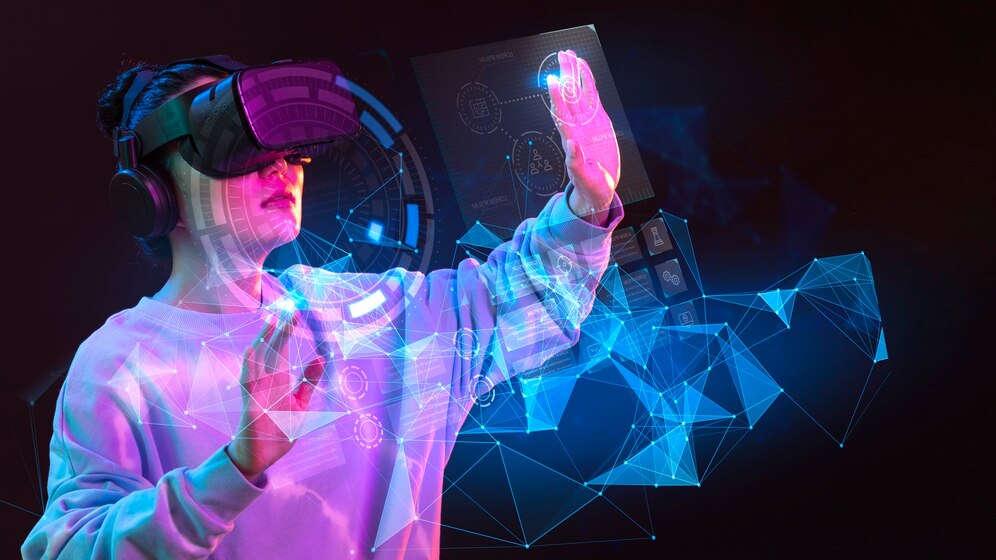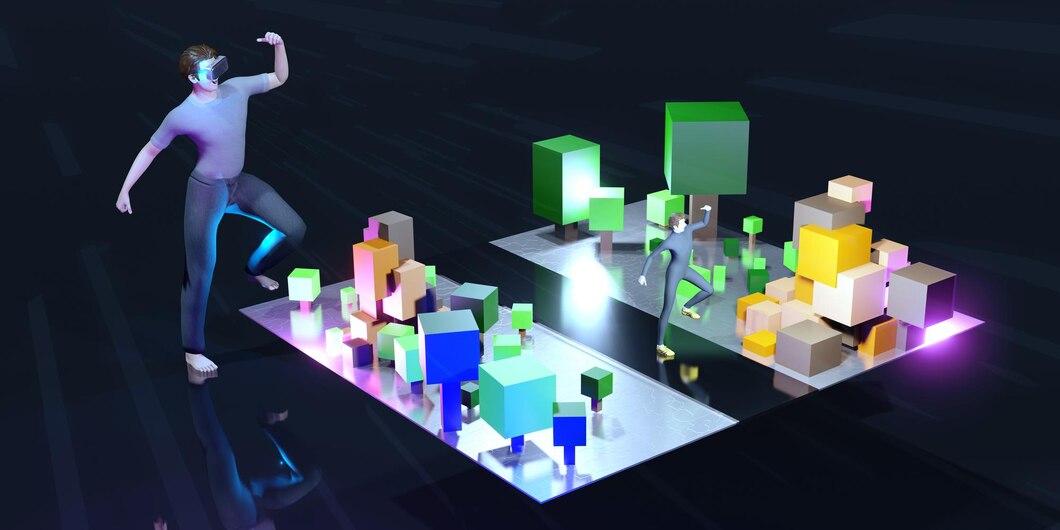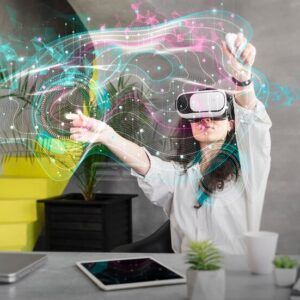In recent years, the term “Augmented Reality” has become increasingly prevalent, revolutionizing the way we interact with the digital and physical worlds. This article delves into the fascinating realm of augmented reality (AR), exploring its definition, applications, technology, and future trends.

What is Augmented Reality (AR)?
At its core, augmented reality overlays digital information onto the real-world environment. Unlike virtual reality, which immerses users in a completely simulated experience, AR enhances our perception of reality by seamlessly integrating computer-generated elements. From early experiments to today’s sophisticated applications, the journey of augmented reality has been nothing short of extraordinary.
How does Augmented Reality Technology Work?
Augmented reality (AR) operates by seamlessly blending digital elements with the real-world environment, enhancing our perception of reality. The process involves the use of sensors, cameras, and sophisticated algorithms.
Here’s a simplified breakdown of how augmented reality works:
Sensors and Cameras
AR devices are equipped with various sensors such as accelerometers, gyroscopes, and GPS, along with cameras. These sensors gather information about the user’s surroundings and movements.
Data Processing
The collected data is sent to the device’s processor, where complex algorithms interpret and analyze the information in real-time. This processing is crucial for understanding the user’s environment.
Digital Overlay
Based on the analysis, the AR system identifies surfaces, objects, and locations in the physical world. It then overlays digital content, such as graphics, text, or animations, onto these real-world elements.
Display
The final step involves presenting the augmented view to the user. This can be through specialized glasses, a smartphone screen, or other AR-enabled devices. The digital elements seamlessly integrate with the user’s actual surroundings, creating an augmented reality experience.
Augmented Reality vs. Virtual Reality vs. Mixed Reality
Let’s dive into the distinctions between Augmented Reality (AR), Virtual Reality (VR), and Mixed Reality (MR):
Augmented Reality (AR)
AR enhances our real-world environment by overlaying digital information onto it. It integrates computer-generated elements like images, text, or animations into our surroundings. An excellent example is the Pokémon GO game, where virtual creatures appear in the real world through your smartphone’s camera.
Virtual Reality (VR)
VR, on the other hand, immerses users in a completely virtual environment, detaching them from the real world. It typically involves wearing a VR headset that covers the user’s field of view with computer-generated imagery. Virtual Reality is like stepping into a different world, making it ideal for gaming, simulations, or virtual tours.
Mixed Reality (MR)
MR combines aspects of both AR and VR, allowing digital and physical elements to coexist and interact in real-time. In Mixed Reality, virtual objects are not just overlaid on the real world but can also respond to and interact with it. Microsoft’s HoloLens is a notable example, where holographic images can be integrated into the user’s physical environment.
Opinion
Each of these technologies offers unique experiences. AR enhances our daily lives by adding valuable information to the real world, VR provides immersive escapism, and MR combines the best of both, fostering a deeper integration of the digital and physical realms. The future holds exciting possibilities as these technologies continue to evolve, offering more seamless and interactive experiences for users.
Applications of Augmented Reality (AR)
Augmented Reality (AR) has found its way into various applications, enriching experiences across different fields. Let’s explore some practical applications of AR:
Augmented Reality in Gaming
Casual and immersive gaming experiences where digital elements interact with the real world. Think Pokémon GO, where players catch virtual creatures in their actual surroundings.
Augmented Reality in Education and Training
AR is transforming education by providing interactive and engaging learning experiences. Students can explore 3D models, historical reconstructions, or scientific simulations in real-time.
Augmented Reality in Business and Marketing
Retailers use AR to enhance the shopping experience, allowing customers to virtually try on clothes or visualize furniture in their homes before making a purchase. AR is also used in marketing campaigns to create interactive and memorable promotions.
Augmented Reality in Healthcare
In healthcare, AR aids in medical training, allowing students to practice surgeries in a simulated environment. Surgeons can use AR during procedures for guidance, displaying vital information without diverting their attention.
Augmented Reality in Navigation and Location-Based Services
AR-based navigation apps provide real-time information about surroundings, making it easier for users to find directions, locate points of interest, or discover nearby businesses.
Augmented Reality in Manufacturing and Maintenance
AR assists in assembly processes by overlaying step-by-step instructions onto physical objects. In maintenance, technicians can use AR to identify and troubleshoot issues in machinery.
Augmented Reality in Architecture and Design
Architects and designers leverage AR to visualize and present projects. Clients can experience virtual walkthroughs of buildings or interior spaces before the actual construction begins.
Augmented Reality in Tourism and Cultural Heritage
AR enhances tourism experiences by providing historical information or virtual guides at tourist attractions. It breathes life into cultural heritage sites, offering visitors a deeper understanding of their significance.
Augmented Reality in Automotive Industry
AR is utilized in heads-up displays (HUDs) in cars, providing drivers with essential information like speed and navigation directions without taking their eyes off the road.
Augmented Reality in Entertainment and Live Events
AR is increasingly used in live events, concerts, and sports broadcasts to create captivating visual effects and enhance audience engagement.
Benefits of Augmented Reality in Manufacturing
Augmented Reality (AR) brings significant benefits to the manufacturing industry, enhancing processes and contributing to overall efficiency.

Here are some advantages of implementing AR in manufacturing:
Improved Efficiency
AR assists workers in following step-by-step visual instructions, reducing the time needed for complex assembly tasks. This leads to increased efficiency on the manufacturing floor.
Enhanced Training Programs
AR facilitates immersive and interactive training experiences. New employees can learn and practice tasks in a simulated environment, reducing the learning curve and improving skill acquisition.
Reduced Errors and Rework
With AR-guided assembly, workers receive real-time visual cues, minimizing the risk of errors. This, in turn, decreases the need for rework and ensures higher product quality.
Remote Assistance
AR enables experts to provide remote assistance by overlaying instructions onto a technician’s field of view. This is particularly beneficial for troubleshooting and solving issues in real-time.
Streamlined Maintenance
Maintenance tasks become more efficient with AR. Technicians can access relevant information and instructions hands-free, allowing for quicker diagnostics and repairs.
Inventory Management
AR applications in logistics and inventory management provide real-time information about stock levels, reducing the likelihood of shortages or excess inventory.
Customization and Prototyping
AR allows manufacturers to visualize and modify product designs in real-time. This aids in the customization of products and accelerates the prototyping process.
Data Visualization
AR overlays relevant data onto physical machinery, giving operators real-time insights into performance metrics. This helps in monitoring equipment health and identifying potential issues.
Improved Safety
AR contributes to a safer working environment by providing safety guidelines and alerts. Workers can be alerted to potential hazards, promoting a culture of safety on the shop floor.
Enhanced Collaboration
AR fosters collaboration among teams by enabling shared visualizations of projects. This is especially valuable for teams working on complex designs or collaborative tasks.
Popular Augmented Reality Examples
Augmented reality is not confined to the realm of imagination; it’s a tangible technology with real-world applications. From interactive advertisements to immersive construction projects, augmented reality is shaping industries and captivating audiences worldwide.
Augmented Reality Devices
The evolution of augmented reality hardware is noteworthy. Augmented reality glasses and smart glasses are stepping into the spotlight, offering users a more seamless and integrated AR experience. The continual advancements in these devices are propelling augmented reality into new frontiers.
Augmented Reality in Various Industries
Augmented reality’s impact extends across various sectors, including healthcare, automotive, and fashion. This section explores the transformative influence of AR in different industries, highlighting how it enhances processes, services, and consumer experiences.
Augmented Reality Platforms and Services
Major players in the tech industry are investing in augmented reality platforms and services. Businesses can leverage these solutions to create unique AR experiences for their customers, opening up new avenues for growth and engagement.
Career Opportunities in Augmented Reality
As augmented reality continues to gain prominence, so do the career opportunities in this field. From augmented reality developers to specialists in AR-driven marketing, the job market reflects the growing demand for skilled professionals who can navigate this innovative landscape.
Future Trends in Augmented Reality
Looking ahead, the future of augmented reality promises even more exciting developments. Emerging technologies, such as augmented reality in healthcare and advancements in AR hardware, are on the horizon, shaping a future where augmented reality seamlessly integrates with our daily lives.
Augmented Reality Challenges and Limitations
While the potential of augmented reality is vast, it’s essential to address challenges and limitations. Ethical considerations, potential misuse, and technological barriers are aspects that merit thoughtful exploration as augmented reality continues to evolve.
Augmented Reality in Everyday Life
Bringing augmented reality closer to home, this section explores how AR is becoming a part of our daily experiences. From navigating city streets to trying on virtual outfits, augmented reality is no longer a distant concept but a practical and enriching aspect of modern life.
Benefits of Augmented Reality Technology
Augmented Reality (AR) offers a myriad of benefits across industries, revolutionizing how we interact with technology. It enhances efficiency by providing real-time, hands-free guidance in manufacturing and assembly, reducing errors and improving overall productivity. AR transforms training programs, offering immersive experiences that accelerate learning curves. Safety is elevated through real-time alerts and guidelines, fostering a secure work environment.
The customization and prototyping capabilities of AR streamline design processes, while its collaborative features enhance teamwork. With applications in logistics, inventory management, and maintenance, AR optimizes various facets of daily operations. As technology evolves, the positive impact of AR on work processes, safety, and collaboration continues to unfold, making it a transformative force in the technological landscape.
Conclusion
In conclusion, augmented reality stands at the forefront of technological innovation, offering boundless possibilities and reshaping the way we perceive and interact with the world. As we witness the continued evolution of AR, the potential for transformative experiences and advancements remains limitless.
Thank you for appreciating the content of this blog. Feel free to visit TheGreatInfo.com frequently to stay informed about the most recent technology trends. Wishing you a fantastic day!
Frequently Asked Questions
Q. What is the fundamental difference between augmented reality and virtual reality?
Augmented reality enhances the real world, while virtual reality creates a wholly simulated environment.
Q. Are there career opportunities in augmented reality?
Yes, the growing field of augmented reality presents diverse career opportunities, from development to marketing.
Q. What are the challenges associated with augmented reality?
Challenges include ethical considerations, potential misuse, and technological barriers.
Q. How does augmented reality work?
Augmented reality works by overlaying digital information onto the real-world environment using sensors and algorithms.
Q. Where can I experience augmented reality in everyday life?
Augmented reality is becoming increasingly integrated into daily life, from interactive ads to navigation apps.
Q. What are the 3 types of augmented reality?
The three types of augmented reality are Marker-Based AR, Markerless AR, and Projection-Based AR.
Marker-Based AR
- Requires a visual marker, like a QR code, to trigger augmented content.
- Commonly used in advertising and interactive experiences.
Markerless AR
- Does not rely on specific markers, utilizing the device’s sensors for content placement.
- Widely used in navigation apps, gaming, and real-world information overlays.
Projection-Based AR
- Involves projecting augmented content onto physical surfaces.
- Used in events, presentations, and interactive displays.
Q. What are the 3 elements of augmented reality?
The three elements of augmented reality are Sensors and Cameras, Data Processing, and Digital Overlay.
- Sensors and Cameras: Gather real-world data and information about the user’s surroundings.
- Data Processing: Involves sophisticated algorithms that analyze and interpret the collected data in real-time.
- Digital Overlay: Integrates computer-generated content, such as graphics or text, onto the user’s view of the real world.





